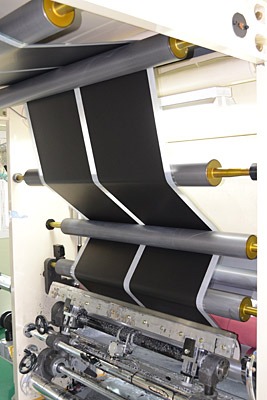Technology of infrared underfloor heating
During the past few years the technology of infrared underfloor heating systems has changed. Therefore, nowadays the infrared underfloor heating systems are the more and more popular choice when installing home heating solutions..
Infrared underfloor heating film Infrared heating film can be mounted in various floors: in concrete, under tiles, wood or laminate floors. During use of the film system, electricity flows through carbon strips, which heat up and radiates 6-20μm length infrared waves. These waves are very similar to what our bodies radiate on their own, so this kind heating is healthy and easily absorbed. During use, no other wave lengths are radiated, so energy is not wasted.

Infrared waves radiated by the human body
Infrared heating does not heat the air, but heats physical objects. Because of these properties, the air during heating, is not high in humidity. Contrary to conventional water floor heating, which creates cold and hot zones on the floor, because of the spaces between the pipes, infrared films surfaces heat evenly. Also, infrared waves travel a lot faster that air diffusion, so the rooms heat up a lot faster than using conventional heating solutions. Heating film starts by heating the top of the floor, then the floor it self transfers heat upwards to zones where people activity is most present. By using infrared underfloor heating film,first of all, the surface of flooring is heated. Then floors release heating upwards to the room. This ensures that the warmth does not stay near the ceilings, but is exactly where people move the most - in the middle of a room.
Using modern technologies infrared film system uses physics for creating maximum comfort.
How the infrared film is made
Infared underfloor heating film is made by using state of the art technologies. It is the primary heating system element.
Production begins with a very thin layer of film, which is made by synthesis of politylene (PE) and polyethylene terephthalate (PET). During the making of the film, its thickens is always adjusted for optimal thinness.
Next, using super precise equipment, a layer of dense carbon paste is sprayed on top of the film to complete the circuit. This paste forms dense carbon atom bonds, which then allows constant and even infrared wave, also known as heat energy, emission. Carbon particles are synthesized with politylene layer for even coating, which allows to create high quality heating solution. The coating is less than 1 micrometer thick.

Next step is to connect the electrodes to the carbon layer. Copper and silver strips are used for fusing and connecting electrodes to the carbon. This process eliminates the chance of sparks and dangers of short circuiting.
Modern and special laminate is used for electrical insulation. It also protects the film components from moisture and damage during mounting process.
The last step is to check if the film meets quality standards and if it does, only then the last 72H heat treating will complete the bonds between the film and the carbon. After this, the film can be cut to size.
Heating film emits heat evenly and is fire-resistant.
Comparison of different heating solutions maintenance and effects on the human body
When creating our home, we are all interested in having the safest, coziest and pleasant surroundings for ourselves and family. Variety of home heating systems create different feeling of warmth.
[table id=1 /]
